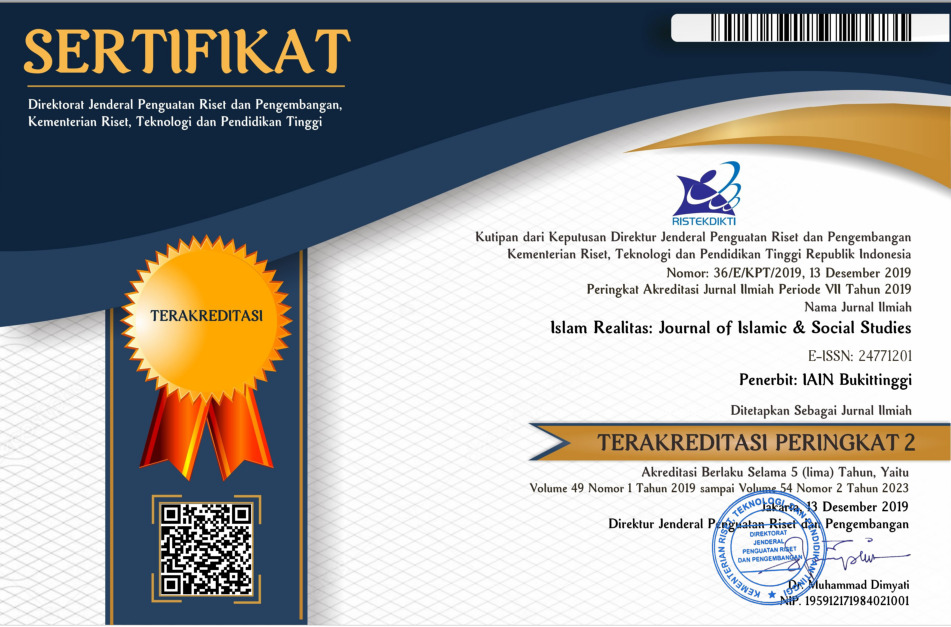Integrating Divine Values in Intercultural Communication Class
DOI:
https://doi.org/10.30983/fuaduna.v3i1.2099Abstract
This research focused on integrating the divine values in Intercultural Communication Class. One of the aims of this subject is to hindrance the communication problems in doing intercultural communication because everyone has different ways of thinking, feeling and doing with their own culture. There are many problems appear in communication if there is no understanding among culture, just like prejudice, racism, or even ethnocentrism. This was descriptive qualitative research, and the data got from observing and interpreting the lecturer’s ways of teaching in Intercultural Communication class especially in integrating the divine values on stereotyping. The result of this research shown that understanding about the negative impact of stereotyping is needed for the students to be a good communicator. In integrating divine values is a must in intercultural communication class in order to the students can create the convenience environment and effective communicator in talking to people which has different culture.
References
Aaronson, Susan Ariel, and Jamie M. Zimmerman. “Fair Trade: How Oxfam Presented a Systematic Approach to Poverty, Development, Human Rights, and Trade.†Human Rights Quarterly 28 (2006). https://heinonline.org/HOL/Page?handle=hein.journals/hurq28&id=1006&div=&collection=.
Abbate, Costanza Scaffidi, Stefano Boca, and Piero Bocchiaro. “Stereotypes in Persuasive Communication: Influence Exerted by a Disapproved Source.†Journal of Applied Social Psychology 34, no. 6 (June 1, 2004): 1191–1207. doi:10.1111/j.1559-1816.2004.tb02003.x.
Bryman, Alan. “Integrating Quantitative and Qualitative Research: How Is It Done?†Qualitative Research 6, no. 1 (February 15, 2006): 97–113. doi:10.1177/1468794106058877.
Chung, Leeva C. “Crossing Boundaries.†In Cross-Cultural Psychology, 375–97. Chichester, UK: John Wiley & Sons, Ltd, 2019. doi:10.1002/9781119519348.ch18.
Dasih, I Gusti Ayu Ratna Pramesti, Ida Bagus Gde Yudha Triguna, and I Wayan Winaja. “Intercultural Communication Based on Ideology, Theology and Sociology.†International Journal of Linguistics, Literature and Culture 5, no. 5 (September 7, 2019): 29–35. doi:10.21744/ijllc.v5n5.738.
Gall, M. D., J. P. Gall, and W. R. Borg. Educational Research: An Introduction. 8th ed. Boston: Pearson, 2007.
Hamid, Sohana Abdul, and Hairun Najuwah Jamali. “Komunikasi Berkesan Membina Sahsiah Pelajar.†Islam Transformatif : Journal of Islamic Studies 1, no. 1 (August 7, 2017): 87–93. doi:10.30983/IT.V1I1.333.
Hartati, Sri, and Muhamad Rezi. “Dimensi Psikologi Dalam Alquran (Analisis Tekstual Tentang Ayat-ayat Alquran).†Islam Transformatif : Journal of Islamic Studies 3, no. 1 (November 13, 2019): 22–29. doi:10.30983/IT.V3I1.844.
Irwandi, Irwandi, Albert Albert, and Nur Azmi Alwi. “Building Teachers’ Intercultural Communication Competence In The Digital Era.†Proceeding IAIN Batusangkar 3, no. 1 (January 25, 2019): 179–82. http://ecampus.iainbatusangkar.ac.id/ojs/index.php/proceedings/article/view/1304.
Lilweri, Alo. Dasar-Dasar Komunikasi Antarbudaya. Yogyakarta: Pustaka Pelajar, 2003.
Pickering, Michael. “Stereotyping and Stereotypes.†In The Blackwell Encyclopedia of Sociology, 1–7. Oxford, UK: John Wiley & Sons, Ltd, 2016. doi:10.1002/9781405165518.wbeoss263.pub2.
Pinelli, Michele, and Mara Einstein. “Religion, Science and Secularization: A Consumer-Centric Analysis of Religion’s Functional Obsolescence.†Journal of Consumer Marketing 36, no. 5 (August 12, 2019): 582–91. doi:10.1108/JCM-11-2017-2451.
Samovar, L., and R. Porter. Intercultural Communication: A Reader. USA: Wadsworth, 2010.
Downloads
Submitted
Accepted
Published
Issue
Section
License
Authors who publish with this journal agree to the following terms:
- Authors retain copyright and grant the journal right of first publication with the work simultaneously licensed under a Creative Commons Attribution-ShareAlike 4.0. that allows others to share the work with an acknowledgment of the work's authorship and initial publication in this journal.
- Authors are able to enter into separate, additional contractual arrangements for the non-exclusive distribution of the journal's published version of the work (e.g., post it to an institutional repository or publish it in a book), with an acknowledgment of its initial publication in this journal.
- Authors are permitted and encouraged to post their work online (e.g., in institutional repositories or on their website) prior to and during the submission process, as it can lead to productive exchanges, as well as earlier and greater citation of published work (See The Effect of Open Access).














